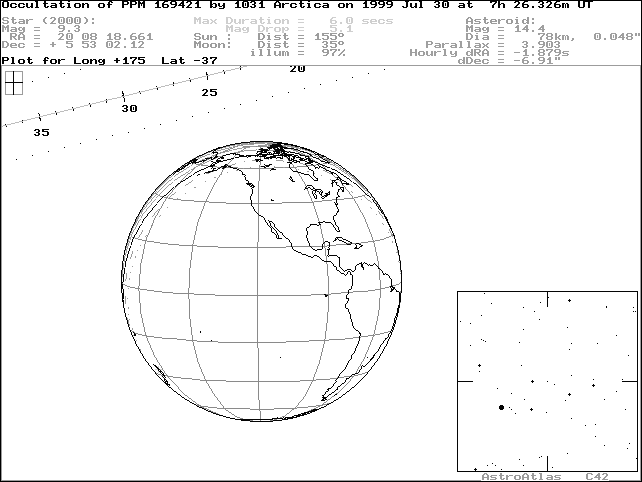ASTROMETRIC UPDATE:
OCCULTATION BY (1031) ARCTICA - 1999 JULY 30
CHECK THIS PAGE REGULARLY FOR FURTHER UPDATES AND CHANGES TO THE TRACK.
YOU MUST RELOAD THIS PAGE USING YOUR BROWSER'S
RELOAD/REFRESH BUTTON TO OBTAIN UPDATES!
[Prediction by Edwin Goffin]
[Prediction using OCCULT software]
The Goffin prediction suggests a path just north of New Zealand and across southeastern Australia. The OCCULT prediction places the path off the Earth to the north, at a time almost FOUR HOURS earlier than the Goffin prediction.
UPDATE: 11 July 1999
This prediction update has been computed by Graham Blow and is based on USNO/Flagstaff and Auckland Observatory astrometry for the minor planet and the Hipparcos star position.
Summary:
IT APPEARS THIS EVENT WILL NOT BE VISIBLE FROM THE EARTH.
The nominal Goffin and OCCULT predictions give enormously different tracks and times, and the astrometry confirms that the track will miss the Earth to the north. Because the star is a HIPPARCOS star, it is assumed that the orbit used by Goffin to predict this event (MPC 14761) is in error.
THE EVENT AT ONE GLIMPSE:
- Date and approx. UT time of event: July 30, 1999 @ 07:26 UT
- Magnitude of target star: 8.29
- Magnitude drop [mag]: 5.1
- Estimated maximum duration [s]: 5.9
- Path description: MISSES THE EARTH.
Data for the target star:
- Name: HIP 99195
- J2000 position [h,m,s; o,',"]: 20h 08m 18.653s; +05o 53' 01.69"
- Position source: Hipparcos
- V mag [mag]: 9.29
Data for the minor planet:
- Number, name: (1031) Arctica
- Approx. diameter [km]: 78
- Source of used astrometry: USN0/Flagstaff (Ron Stone) and Auckland Observatory (Ian Griffin)
- Number of used observations: 5 USNO + 4 AO
- Number of rejected observations: 0
- Time covered by the observations: 1999 06 30 - 1999 07 10
Data for the event:
- UT date and time of least geocentric approach: 07:26 UT
- Approx. V mag of minor planet at event [mag]: 14.4
- Geocentric parallax of minor planet ["]: 3.903
- Magnitude drop [mag]: 5.1
- Estimated maximum duration [s]: 5.9
- Apparent motion of minor planet ["/h]: 28.88
- Angular distance to moon, phase of moon [deg,%]: 36, 96%

IMPORTANT NOTE!
Astrometric updates such as these should not be taken as definitive, but rather only as an indication of where the true track may lie relative to the original predicted track. Observers must bear in mind that later astrometry, in which the target star is measured in the same field as the asteroid, may still reveal substantial changes to the predicted track and time of the event. For this reason it is most important that observers far from the predicted track still monitor the event.
Use these links for further information:
[Planetary Occultations]
[Using the Predictions]
[Observing Details]
[Timing Details]
[Reporting Details]
[Report Form]
[Asteroid Occultation Results]
This page may have been updated since 30 June 1999.
Hit your browser's RELOAD button to get the latest version.
[Site Map]
[What's an Occultation?]
[Total Occultations]
[Grazing Occultations]
[Planetary Occultations]
[Jovian Satellite Eclipses]
[Timing Occultations]
[Reporting Observations]
[Coming Events]
[Software]
[About Us]
[Publications]
[Membership]
[Links]
[Top of Page][Return to Home Page]
